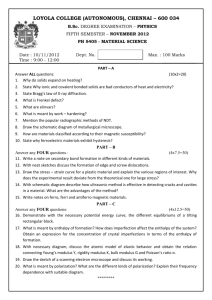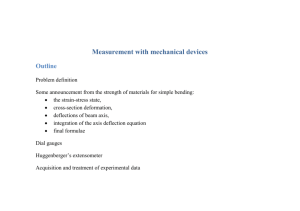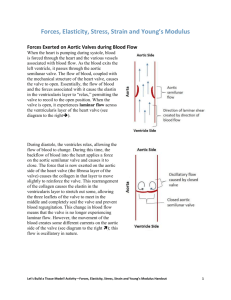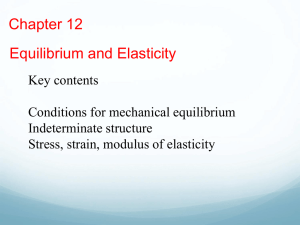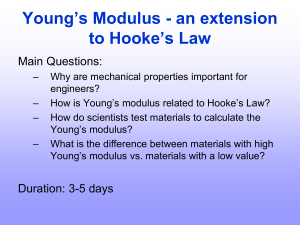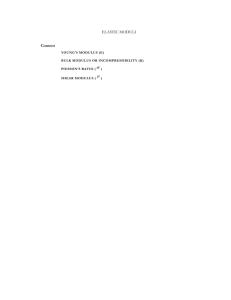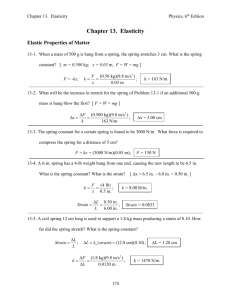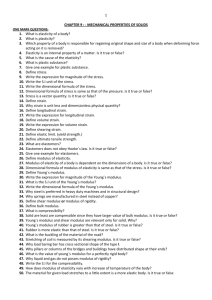Word
advertisement
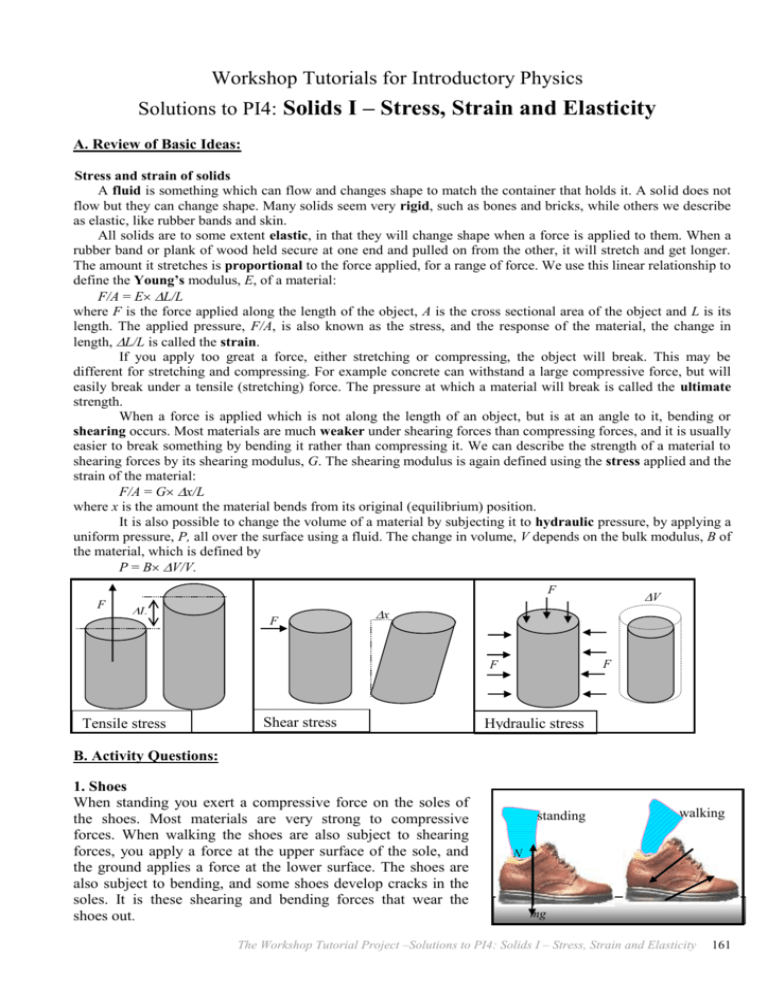
Workshop Tutorials for Introductory Physics Solutions to PI4: Solids I – Stress, Strain and Elasticity A. Review of Basic Ideas: Stress and strain of solids A fluid is something which can flow and changes shape to match the container that holds it. A solid does not flow but they can change shape. Many solids seem very rigid, such as bones and bricks, while others we describe as elastic, like rubber bands and skin. All solids are to some extent elastic, in that they will change shape when a force is applied to them. When a rubber band or plank of wood held secure at one end and pulled on from the other, it will stretch and get longer. The amount it stretches is proportional to the force applied, for a range of force. We use this linear relationship to define the Young’s modulus, E, of a material: F/A = E L/L where F is the force applied along the length of the object, A is the cross sectional area of the object and L is its length. The applied pressure, F/A, is also known as the stress, and the response of the material, the change in length, L/L is called the strain. If you apply too great a force, either stretching or compressing, the object will break. This may be different for stretching and compressing. For example concrete can withstand a large compressive force, but will easily break under a tensile (stretching) force. The pressure at which a material will break is called the ultimate strength. When a force is applied which is not along the length of an object, but is at an angle to it, bending or shearing occurs. Most materials are much weaker under shearing forces than compressing forces, and it is usually easier to break something by bending it rather than compressing it. We can describe the strength of a material to shearing forces by its shearing modulus, G. The shearing modulus is again defined using the stress applied and the strain of the material: F/A = G x/L where x is the amount the material bends from its original (equilibrium) position. It is also possible to change the volume of a material by subjecting it to hydraulic pressure, by applying a uniform pressure, P, all over the surface using a fluid. The change in volume, V depends on the bulk modulus, B of the material, which is defined by P = B V/V. F F L F F F Tensile stress V x Shear stress Hydraulic stress B. Activity Questions: 1. Shoes When standing you exert a compressive force on the soles of the shoes. Most materials are very strong to compressive forces. When walking the shoes are also subject to shearing forces, you apply a force at the upper surface of the sole, and the ground applies a force at the lower surface. The shoes are also subject to bending, and some shoes develop cracks in the soles. It is these shearing and bending forces that wear the shoes out. standing walking N mg The Workshop Tutorial Project –Solutions to PI4: Solids I – Stress, Strain and Elasticity 161 2. Rubber bands The rubber band that stretches the least for a given weight (applied force) has the greatest spring constant. If you had rubber bands of the same cross sectional area then the one that stretches the least also has the greatest elastic modulus. The area is the width times the thickness, so if the thickness is similar the area can be estimated from the width of the band. If you cut a strip of rubber in half it would stretch less for a given weight, so its spring constant will have decreased, but it will stretch by the same proportion. The modulus of elasticity depends on the material, and will not have changed. If you joined two rubber strips or bands together in parallel they would also stretch less, but again the modulus of elasticity has not changed. Effectively you will have doubled the spring constant by doubling the cross sectional area. 3. Breaking chalk The chalk is much easier to break by twisting or bending, as it has a greater ultimate compression strength than either torsional or shearing strength. This is also the case for bones. Bending, twisting and stretching the chalk opens up micro-cracks in the material, allowing it to “come apart”, compression tends to close these cracks. C. Qualitative Questions: 1. Bounciness of balls. a. When the ball is hit it deforms, and then springs back into shape. There is internal friction as the ball changes shape and this increases the temperature of the ball. b. As the temperature of the ball increases the air inside it expands and stretches the surface of the ball. On impact a taut surface converts kinetic energy into elastic potential energy, and is able to efficiently convert it back again. A soft surface converts the kinetic energy into a rearrangement of molecules and is unable to reverse the conversion, and thus the kinetic energy is absorbed and the ball doesn’t bounce. c. As above, a taut surface is an efficient energy converter. 2. Bones and tendons. a. The behaviour of the bone is closer to Hookean, as Hooke’s law, F = k x, predicts a linear response (strain) to an applied force (stress). b. Bones are more rigid than tendons, and do not stretch as much for a given force, tendons are “stretchier”, and will also break at a lower applied stress. c. Using the relationship: Stress = Young’s modulus strain, bone has the greater Young’s modulus as it has the steeper slope on the stress-strain graph. stress bone tendon strain D. Quantitative Question: a. The maximum weight the legs can support standing vertically is 17 107 N.m-2 3.0 cm2 = 17107 3.010-4 = 51k N or 5100 kg (5.1 tonnes!) each. For two legs this is 100,000 N or 10 tonnes. b. We can use F/A = E l/l where F is the force applied, A is the cross sectional area of the bone, E is the Young’s modulus and l is the length of the bone. Rearranging this equation gives: l = Fl/AE = 85 kg 9.8 ms-2 0.40 m / (2 3.010-4m2) 1.81010 Nm-2 = 3.010-5m . c. You should bend your knees when landing from a fall so that the impact is spread over time, deacceleration is minimised, and the force is less. d. Most broken bones are due to twisting or bending of bones, not compression. Skiing in particular tends to cause twisting of leg and ankle bones. 162 The Workshop Tutorial Project –Solutions to PI4: Solids I – Stress, Strain and Elasticity

